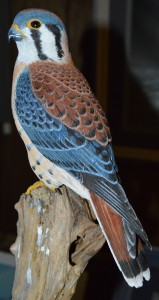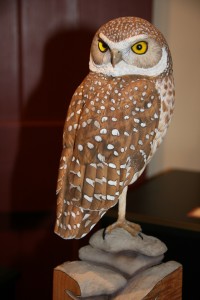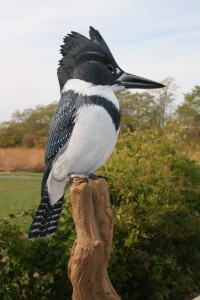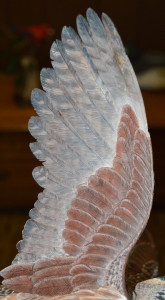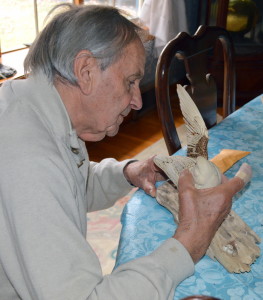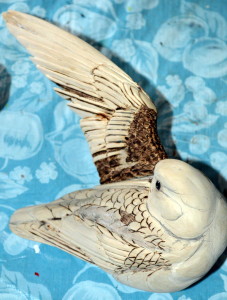Artists Taking Flight at Audubon Expo
“This guy walks into a bar and sees two people in a corner carving wood…” No, this isn’t the opening to a joke. It’s a bit of biography concerning one of the many carvers who will be putting in an appearance this weekend at Audubon Society of Rhode Island’s Bird and Wildlife Carving Exposition in Bristol. The two day event features 17 artists from around New England and New York who devote hundreds of hours bringing hunks of Louisiana wood called Tupelo into intricate carvings of Ospreys, Goldfinches, Chickadees, and more. Though the specifics of their backgrounds differ, all are nothing if not saintly in their level of patience with their art.
Al Jordan has been carving birds since 1990, though his love for birds, particularly raptors, dates back much further than that. “When I was about two years old, I went with my father to Hawk Mountain in Pennsylvania. I remember playing on a rocky ledge with my brother. All of a sudden I looked up and saw a pair of Golden eagles soaring not ten feet above me. They could have swooped down and scooped us both up.” Rather than being traumatized at the realization, though, Jordan became fascinated with raptors, thus beginning a lifelong love that continues to this day. Not only is Jordan a professional bird carver who specializes in raptors, but he also is a master falconer, keeping two Harris’ hawks and a Goshawk.
Jordan was one of the men carving birds while in a bar, a business he co-owned. His business partner at that time gave Jordan a piece of wood, and helped him make his first bird. “We would sit in the corner of the bar carving during our down time. In fact, once I had been carving for about a year, a customer bought a pair of chickadees I had carved. That was my first sale.” Years later, Jordan would be commissioned to do his largest work: a life sized Golden eagle carrying a ground squirrel to its nest. The 80-inch piece was commissioned by the Denali National Park Visitor’s Center in Alaska. That commission came from a referral by an ASRI visitor who had seen his work at the Bristol event.
For Eric Kaiser, another artist heading to Bristol, a life-sized eagle was also one of his most memorable carvings; one that took him a full year. To say that Kaiser’s approach to his art is elaborate would seem an understatement. “It takes a while to get something good; you have to be a sculptor, a painter, you need to be good at mixing colors, woodworking. I’ll usually do a clay study as a starting point; the resulting sculpture is where a lot of people would leave off, calling it a finished piece. You also have to know a little bit of anatomy, as well as being comfortable with working with different materials used in painting and sealing.”
Like the other artists interviewed, Kaiser is self-taught. “When I started out 30 years ago, there wasn’t that much information available on carving. Now there are videos online, along with lessons often sponsored by museums. It’s pretty easy for guys to get their feet wet; the information out there is incredible.”
Each of the three men also shared another characteristic: their move from amateur to pro arose from the ashes of a forced career change, a kind of blessing in disguise. The boating company Kaiser owned in his early carving years went out of business. Kaiser spent a good amount of his time thinking about his next move, but he also spent it carving. “One day I brought three or four carvings that I thought were okay to a gallery. They bought them on the spot. That’s what made me think I could make a living doing this.”
Attleboro native Raymond Tameo’s full time carving life also arose from a glitch in his original career, then as a designer with a civil engineering firm. When his company began to move in a new direction, Tameo decided it was time to retire. Back as far as the 1980’s, Tameo had been exposed to the pleasure of carving and compensation: “Back then, Caratunk Audubon was hosting a display of bird carvings. I didn’t even intend to sell anything, but a woman surprised me by offering to buy a Red Winged blackbird that I had done. I mean, it’s one thing to look at a nice bird carving, but it’s another to pay for it.”
Tameo estimates it takes somewhere around 150 – 200 hours to complete a finished bird. The added complexity of carving a bird with its wings extended increases the amount of hours involved. Tameo begins with a hunk of Tupelo wood and carves a profile of the bird with a band saw. As the piece progresses, he’ll work with a Dremel tool, carving knives, a wood burner (for marking the intricate details of each feather), a sealer, and then finishing in acrylic paint.
Since that first sale, Tameo says the quality of his work continued to grow, and he also mastered the art of painting birds in his favored medium of acrylics. His largest carved piece is a trio of Canada geese currently on display at the renovated Grist Mill in Seekonk, Massachusetts. Of his growth as an artist, he says, “I just kept at it. That’s what you need to do. I’m sure (classical violinist) Isaac Stern started out his playing by squeaking away on his violin, but he just kept at it.”
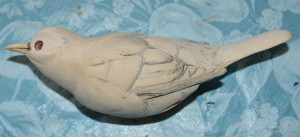 The Bird and Wildlife Carving Exposition will be held November 7 & 8, from 10:00 am – 4:00 pm at the Audubon Environmental Education Center, 1401 Hope Street, Bristol, RI. For more information, visit www.asri.org.
The Bird and Wildlife Carving Exposition will be held November 7 & 8, from 10:00 am – 4:00 pm at the Audubon Environmental Education Center, 1401 Hope Street, Bristol, RI. For more information, visit www.asri.org.

